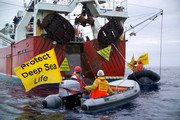
This an
article published by
JET magazineBeing an Activist
When asked the question, “what do you want to be when you grow up?” I always said, “I don’t know, a lawyer, maybe an architect?” Then one day a few years ago I thought about it and realised that somehow I was actually being paid to be an environmental activist! This came as quite a surprise to me because I never planned to have a career working on protecting the environment, and up until that point had always done it just because it was fun and exciting.
I currently work for the Green Party of Aotearoa/New Zealand, as the Youth Campaigner and before that I worked for Greenpeace New Zealand and Australia in a variety of roles. Being an activist isn’t your normal run-of-the-mill job, and there isn’t a school you can go to get training in it. It is a job that has far more to do with your personality than your education. In the beginning, all you need is the willingness to contribute to a campaign that is important to you, and dedicate your time, effort and creativity to achieving that goal. There isn’t one thing that you have to be good at to be an activist – you need lots of different skills, but one of the most important is being able to talk to groups of diverse people like politicians, volunteers, or just your average person on the street. You have to know your stuff, and do as much research as possible, so that if you’re asked a question you can give a good and accurate answer. You have to be organised and able to organise other people, and you have to be able to use technology such as email and the internet. Lastly you must be positive in everything that you do. When you’re talking about a problem, you also have to know what the solution is, and how to get there. A big part of being an activist is encouraging people to believe that there is a solution to a problem, and they can be apart of the answer.
I have been involved in heaps of different campaigns over the last six years such as working on climate change, keeping genetic engineering out of New Zealand’s environment, toxic pollution, and recently helping to keep Wellington’s trolley buses. There are lots of different ways you can campaign towards a positive solution – you can lobby and approach politicians (by writing them letters or having a meeting with your local electorate MP); you can get publicity (by organising a march or painting a banner); you can help publish reports; and you can inform the public of what’s happening (by handing out leaflets or organising a public meeting). You can ask people to sign a petition; or write a letter; or to boycott something. I think the funnest part of being an environmental activist is doing non-violent direct action: when you take peaceful action to stop or save something – like when Ghandi went on hunger strike in protest; when the founders of Greenpeace sailed into a nuclear test site; or when I dressed up as Roland McDonald and chained myself to a gate to stop the delivery of genetically engineered ingredients.
My Time on the Rainbow Warrior

One campaign that I have been involved in over the last few years is trying to stop high seas bottom trawling, because it is the world’s most damaging fishing method. Bottom trawling involves dragging nets – larger than a football field, with big metal rollers along the ocean floor to collect fish. The problem is that you don’t just catch what you’re looking for, but you also catch everything else: corals and sponges and other fish and animals that live on the ocean floor. The deep sea is an amazing place. It is totally dark, frigidly cold, and is under such great pressure that it would crush a person. It is one of our last wildernesses, and more people have been to the moon, than the deep ocean floor. Scientists estimate there could be 100 million unknown species down there; still, bottom trawling is like clear felling undersea coral forests, and those species are killed before scientists get the chance to study them properly. Bottom trawling is like ‘blowing up Mars before we get there.’
In 2005, I was lucky enough to sail on the Rainbow Warrior. We sailed into the Tasman Sea to do what governments around the world weren’t doing – stopping the bottom trawlers. We left Auckland in May, sailing north. Nearly everyone got sea-sick; it was absolutely horrible hearing everyone vomiting and moaning and not able to do much work for the first couple of days. I was lucky and did not get sick, and because of this I was called ‘cast-iron guts’ by the crew. However, this was a mixed blessing and meant that I had to take over some of the cooking duties for the crew of 26 meat-eaters and vegetarians aboard.
As we sailed north, the weather got progressively worse, and we learnt that around the tip of the North Island were massive 10 metre plus waves. We had to shelter near New Zealand’s most northerly point for the weather to clear and we for the next few days we spent training and practicing. Greenpeace is famous for its zodiac inflatables, and the images of activists in between the whale and the harpoon. However, you never see all the effort that goes into launching one of them. It takes the Captain (who in our case was the Captain of the original Rainbow Warrior which was blown up 20 years earlier) managing the crane; the boson, yelling instructions; and four people holding four large ropes to stop the inflatable from wobbling too much. The boat was then placed on the side of the Warrior, before dropping it into the (usually heaving) sea bellow with its crew. It is potentially dangerous work, but after a few practice runs we could launch them quickly, and in the dark if necessary.
While at anchor, we took the opportunity to treat the mostly foreign crew to a New Zealand tradition – the BBQ. The occasion was a birthday on board, and somehow a cake was produced, one crew member even had a bow-tie, and we danced into the early hours. It must have looked hilarious to other ships at anchor to see people dancing in the bridge (the steering and chart room) of the Rainbow Warrior.
It got to the point that the forecast wasn’t improving, and if we stayed at anchor we’d miss our chance of catching the bottom trawlers; so the captain made the decision to brave the waves and head into the Tasman Sea. The sea truly was ferocious, with waves crashing over the ship and people being thrown out of their bunks at night, and oh; it started another crew-wide bout of sea-sickness.
The routine on board was that the Captain and mates would rotate shifts keeping watch, while the rest of the crew worked a normal 8 hour day. We would be woken at 7, start work at 8, do half an hour of cleaning before the other jobs that needed to be done for that day. My position was as a deckhand, which meant that when we weren’t launching the inflatables I was painting, chipping rust or organising things in the hold. There would be a regular morning tea, lunch and afternoon tea brakes, but just the act of constantly holding on to things and maintaining balance meant that you would be famished by meal time. 5 o’clock was time to down tools and have a drink, and usually stare at a glorious sunset before dinner and then usually someone would play a guitar, or we would watch a movie. If the Captain could be persuaded he might stop the ship and let us have a swim – absolutely freezing being the middle of winter, but having huge albatrosses in the water with us made up for it.
It wasn’t until the tenth day at sea before we found our first bottom trawler: the Tasman Viking. We were woken at 6am and told that we found the ship on the radar that night. So I donned my activist kit: thermals; wet-weather gear; helmet; goggles; knife (in case we had to cut ourselves free); life jacket; vest with Stop Deep Sea Destruction written on it and a personal banner. Then we launched the inflatables and set off in pursuit of the trawler. It was depressing watching the trawler pull up its net, full of fish, and it reminded me of the landfill back in Gisborne (where I grew up) but instead of seagulls, there were hundreds of albatrosses circling the trawler; all fighting to get the by-catch that is thrown overboard.
We found two more ships soon afterwards – the Westbay and the Ocean Reward – all New Zealand trawlers taking part in the destruction of the deep. On the twelfth day we started doing non-violent direct action on the Ocean Reward, such as tying and inflating a large 20 person emergency life raft to the trawl nets, so it couldn’t be sunk; locking a cable in between the trawl doors, so the net couldn’t work; and locking plastic barrels to the net – so they would have to haul the net back on board, to chop the barrel off before laying the net out again…when we’d tie another barrel on…and repeat. The most effective tactic was just racing the zodiacs right up the stern (back) of the ship so they couldn’t lay the net out. Obviously our actions annoyed them greatly and they used different ways to show this such as throwing fruit and fish at us; building a mortar to hurl potatoes at us; and using their high pressure fire hose on us. It was surreal being in the middle of the Tasman Sea and having a fisherman yell at me, “why don’t you go and get a real job!”
Our actions gained media interest and widespread support around the world and we when we found the New Zealand trawler, the Waipori, throwing overboard a massive man-sized piece of coral: we knew we had found more damning evidence to take to the United Nations Generals Assembly, who in November were to make a decision on the future of bottom trawling. My three weeks aboard the Warrior were exciting and a lot of fun and best all, successful in terms of the campaign. I believe that trying to save the world doesn’t have to be all about seriousness and sacrificing things, it has to be fun as well.
We need our Government to support the moratorium on bottom trawling in International waters at the United Nations, and you can write the Prime Minister Helen Clark, (freepost Parliament) asking her to support the moratorium. If you would like to find out more about the campaign visit www.greenpeace.org.nz or www.savethehighseas.org
# posted by gareth @ 3:35 PM

 This an article published by JET magazine
This an article published by JET magazine



